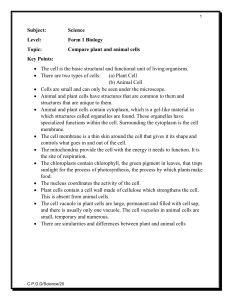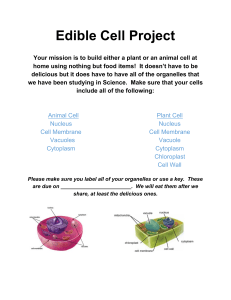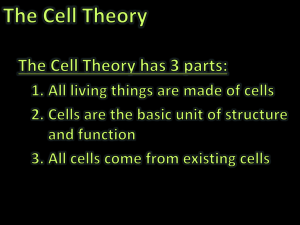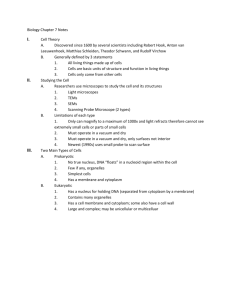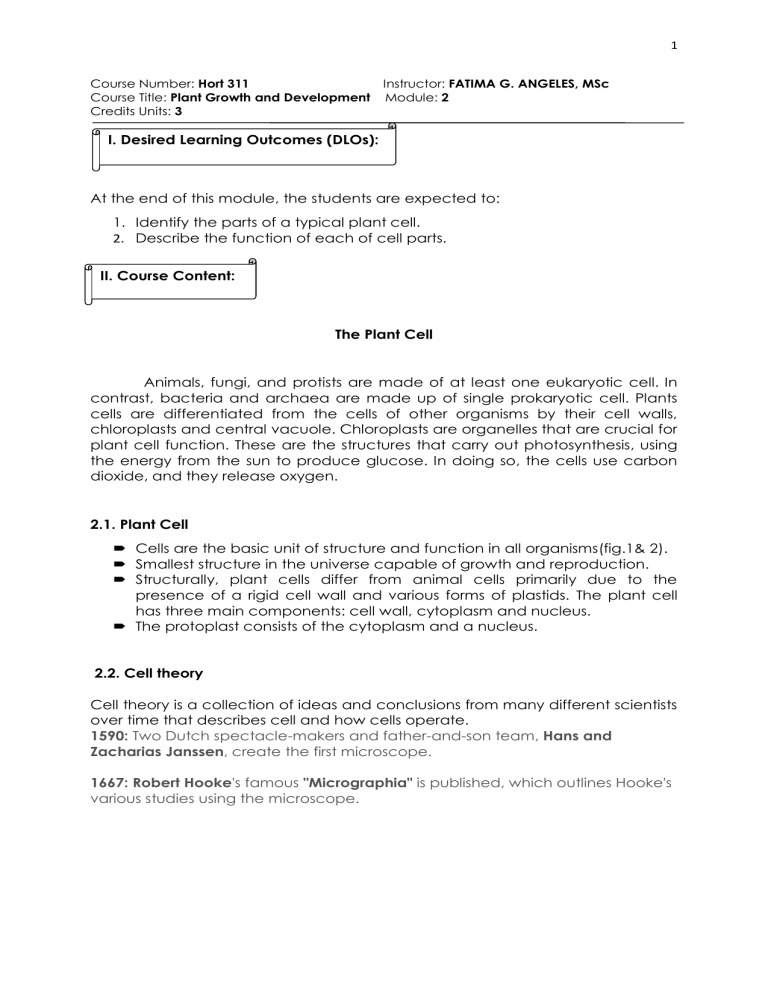
1 Course Number: Hort 311 Instructor: FATIMA G. ANGELES, MSc Course Title: Plant Growth and Development Module: 2 Credits Units: 3 I. Desired Learning Outcomes (DLOs): At the end of this module, the students are expected to: 1. Identify the parts of a typical plant cell. 2. Describe the function of each of cell parts. II. Course Content: The Plant Cell Animals, fungi, and protists are made of at least one eukaryotic cell. In contrast, bacteria and archaea are made up of single prokaryotic cell. Plants cells are differentiated from the cells of other organisms by their cell walls, chloroplasts and central vacuole. Chloroplasts are organelles that are crucial for plant cell function. These are the structures that carry out photosynthesis, using the energy from the sun to produce glucose. In doing so, the cells use carbon dioxide, and they release oxygen. 2.1. Plant Cell Cells are the basic unit of structure and function in all organisms(fig.1& 2). Smallest structure in the universe capable of growth and reproduction. Structurally, plant cells differ from animal cells primarily due to the presence of a rigid cell wall and various forms of plastids. The plant cell has three main components: cell wall, cytoplasm and nucleus. The protoplast consists of the cytoplasm and a nucleus. 2.2. Cell theory Cell theory is a collection of ideas and conclusions from many different scientists over time that describes cell and how cells operate. 1590: Two Dutch spectacle-makers and father-and-son team, Hans and Zacharias Janssen, create the first microscope. 1667: Robert Hooke's famous "Micrographia" is published, which outlines Hooke's various studies using the microscope. 2 Robert Hooke – first saw cells 1665 – Hooke’s drawing of Cork Cells Development of Cell Theory of Life 1. 1838 – Matthias Schleiden – stated all plants composed of cells 2. 1839 – Theodor Schwann – stated all animals also composed of cells – thus claimed all living things composed of cells 3. 1858 – Rudolf Virchow – all cells come from preexisting cell 4. 5. Matthias Schleiden Theodor Schwann Rudolf Virchow The following are the parts and functions of the plant cell: A. Plant Cell Walls Plant cell walls have a large role in plant growth and development. The shape of a plant is ultimately determined by the shapes of its many cells. The shapes of plant cells, in turn, are determined by their cell walls. Outer protective layer of cells Generally have 3 layers: Middle lamella – intercellular substance, primarily pectins, that cements adjacent cells together. Primarily wall – wall layer formed before and during growth of cell – relatively thin and not rigid; stretched as the cell grows. – consists of loose network of cellulose microfibrils. Have thin areas called primarily pit fields traversed by numerous protoplasmic strands called plasmodesmata. B. Cytoplasm 1. All the protoplasm of living mater of the cell apart from the nucleus 2. The fluid or gel-like material in which the cell’s organelles and internal membrane systems are suspended. Cytoplasmic streaming/cyclosis – flowing movement of the cytoplasm 3 for efficient distribution of substances absorbed from the outside of the cell and substances released by the nucleus and other organelles. consists of the following membrane systems and organelles: 1. Plasmalemma/plasma membrane/cell membrane – external membrane of the cell composed primarily of lipids which prevent most water soluble materials from passing through Functions: a. Mediates the transport of substances into and out of the cell b. Coordinates the synthesis and assembly of cell wall microfibrils c. Translates hormone and environmental signals involved in the control of cell growth and differentiation 2. Endoplasmic Reticulum (ER) – system of paired membrane sheets/tubules ramifying through the cytoplasm. Types: a. Rough or granular ER – consists of flattened disks or sacs called cisternae with numerous ribosomes attached to its outer surfaces; found in cells that secrete or store proteins. b. Smooth or angular ER – consist of a system of tubules; lacks ribosomes. Functions: a. Communication system within the cell, channeling the material e.g proteins and lipids to different parts of the cell b. Principal site of membrane synthesis; appears to vacuolar and microbody membranes as well as cisternae dictyosomes synthesize of 3. Dictyosome/Golgi Apparatus– stack of smooth, flat, disk-shaped sacs or cisternae often branched into a complex series of tubules and vesicles at their margins. Functions: a. Secrete protein and carbohydrates products from the cell to its exterior e.g. nectar. b. Synthesis of cell wall polysaccharides. 4. Microtubules –long thin cylindrical structures about 24 nm in diameter of varying lengths Functions: a. Involved in the orderly growth of the cell wall especially in the alignment of the cellulose microfibrils. b. Direct dictyosome vesicles toward developing wall 5. Microfilaments – contractile proteins composed of actin similar to that of muscle tissue which occur as long filaments 5 to 7 nm thick; occur bundles. Function: play a causative role in cytoplasmic streaming. 4 6. Plastids – Largest cytoplasmic organelles which vary in size, form and pigmentation. Types: a. Chloroplast – usually disk-shaped about 4-6 um in diameter – green due to the predominance of chlorophyll pigment Functions: 1. Site of photosynthesis 2. Amino acid and fatty acid synthesis b. Chromoplast – yellow, orange or red due to presence of carotenoid pigments Function: Acts as attractants to insects and other animals due to bright colors they give to the plant organ. c. Leucoplasts – non pigmented plastids; occur in storage cells Types: 1. Amyloplasts – contain starch 2. Protein plasts – contain proteins 3. Elaeio plasts – contain fats and oils 7. Mitochondria – spherical, elongated and sometimes lobed organelles, about half a micrometer in diameter. Function: site of respiration, producing principal energy source (ATP) for the cell’s metabolic reactions 8. Microbodies– spherical organelles bounded by a single membrane, about 0.5 to 1.5 um in diameter. Function: some microbodies called peroxisome play an important role in glycolic acid metabolism associated with photorespiration 9. Ribosome – small particles, about 17-23 nm in size containing RNA and protein Function: site of protein synthesis 10. Vacoules– membrane-bounded regions within the cell filled with a nonliving liquid called cell sap; the outer membrane is called tonoplasts Functions: a. A means for the cell to increase in size b. Important storage compartments from various metabolites such as reserve proteins in seeds and malic acid in CAM plants c. remove toxic products from the cytoplasm e.g. nicotine C. Nucleus 1. Most prominent structure within the cytoplasm; considered the “heart of the cell” Bounded by a pair of membranes, the nuclear envelope Contains DNA, the genetic material in dark-staining thread-like structures called chromatin (chromosomes when condensed) and nucleoli Function: controls cell maintenance and development by instructing the cells ribosome to synthesize particular proteins Nucleolus – spherical dark-staining structures found in non-dividing nuclei. 5 Fig. 1 Plant Cell Summary Fig. 2 Plant cell III. References: https://www.slideshare.net/KhanSaif2/cell-structure-and-function-110716980 https://www.microscope.com/education-center/microscopes-101/history-ofmicroscopes 6 7 IV. ASSESSMENT Name:_________________________________________ Course/Yr. /Sec:_________________________________ S.Y. 2023-2024 Score:_______ Assessment 1. Instruction: Read and understand each statement carefully. Write the correct answer on the space provided. 1. __________________The basic unit of life. 2. __________________ Who are the two Dutches spectacle-makers and father-and-son team created the microscope? 3. __________________Who first discovered the cell in 1665? 4. _________________The scientist who stated that all plants composed of cells. 5. __________________ Known as the site of photosynthesis, Amino acid and fatty acid synthesis. 6. _________________ The fluid or gel-like material in which the cell’s organelles and internal membrane systems are suspended. 7. _________________The organelle that is known as the site of respiration, producing principal energy source (ATP) for the cell’s metabolic reactions. 8. ________________ A small particles, about 17-23 nm in size containing RNA and protein it is known as the site of protein synthesis. 9. ________________ The organelle which function as storage compartments from various metabolites such as reserve proteins in seeds and malic acid in CAM plants, remove toxic products from the cytoplasm e.g. nicotine. 10. _________________ The most prominent structure within the cytoplasm; considered the “heart of the cell”. 8 Assessment 2. Instruction: Answer the following question. Spelling and grammar are important. Criteria: Organization ofidea:2 pts. Content: 2pts. Grammar: 1pt. 1. Identify and describe the parts and function of each of cell parts. Explain using words and diagrams.

